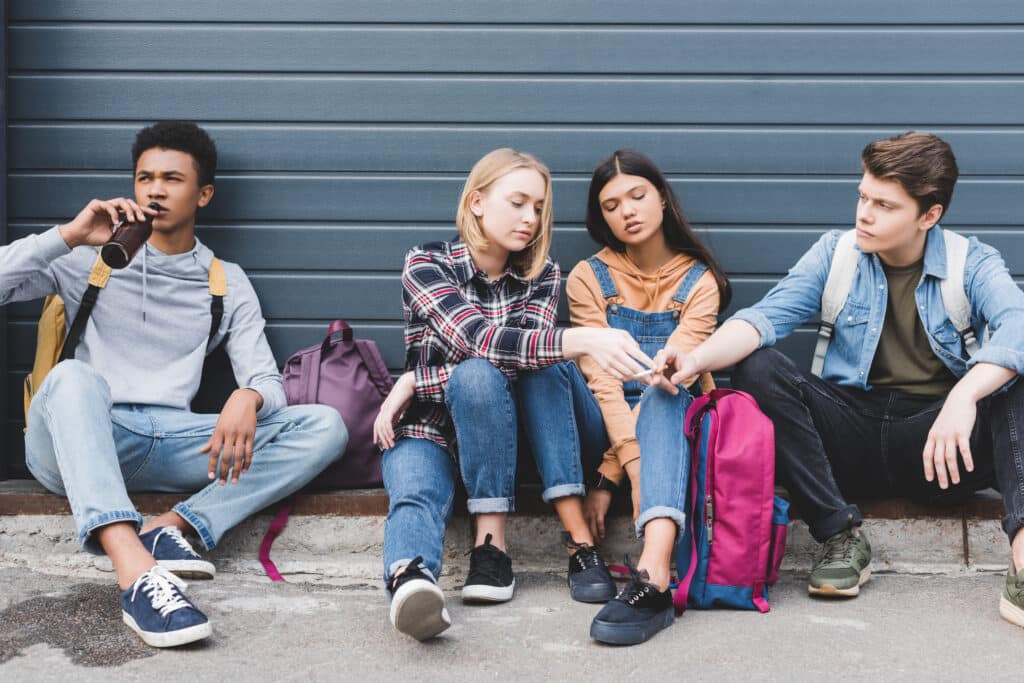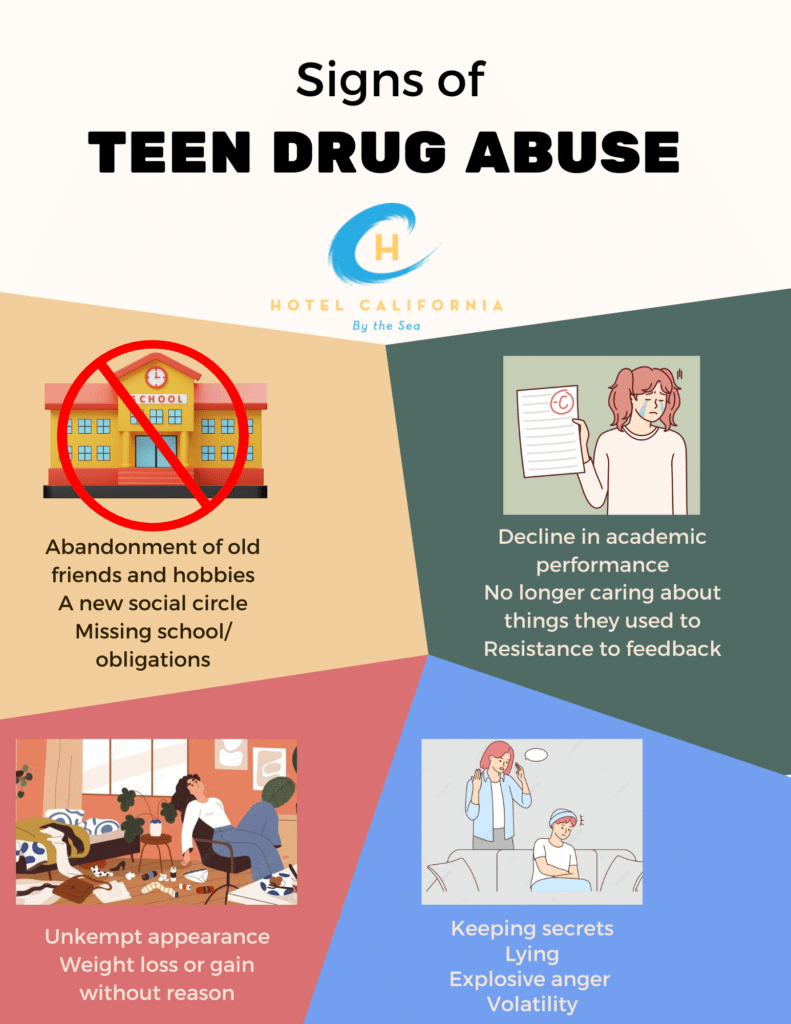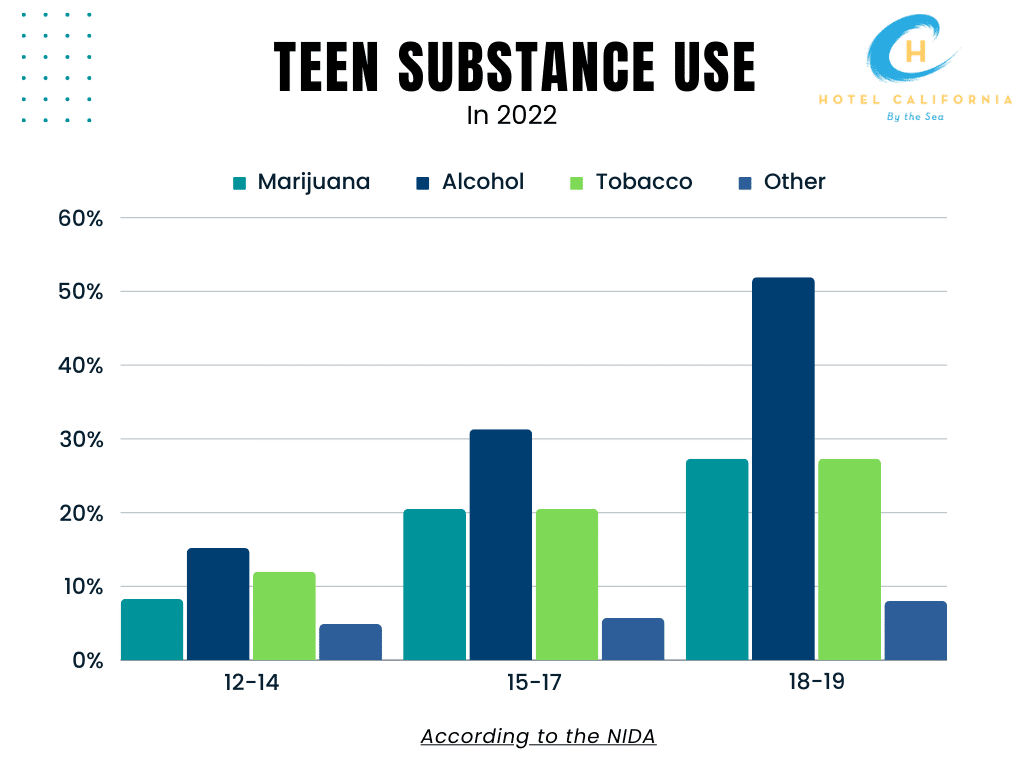What is the number one Drug used by Teens?
Youth and adolescents experimenting with drugs and substances is not a new occurrence. It is quite common. Young people often cannot connect the link between their drug-using actions and risky consequences in the future. Because their brain has not fully developed, they cannot comprehend the impact of their actions and behaviors. Teens and young adults tend to feel untouchable and indestructible to the consequences of drug and alcohol use. This leads to the reckless use of alcohol, prescription medications, inhalants, over-the-counter cold and cough medications as well as illegal substances.
According to research, half of all new drug users are under the age of 18. In fact, a 2016 study found about half of college students reported using illicit drugs. Data shows an estimated 45% of male and 42% of female college students reported using illegal substances. The majority of adults who end up developing an addiction first experiment with drugs and substances before they turn 21. Experimentation plays a significant role in teen drug use. However, experimentation and use aren’t synonymous with abuse and addiction.

What is the number one Drug used by Teens?
According to the National Institute on Drug Abuse (NIDA), alcohol is the number one substance used and abused by teens in America. The study also found that marijuana was the second most popular substance of use among teens and young people. Among the most commonly used substances, alcohol, marijuana and prescription medications were at the top of the list.
Alcohol is the most commonly used mind-altering substance used by teens. It is a legal substance. It is legal for people over 21 to purchase and consume. It is easily accessible. Alcohol is sold in grocery stores, specialty stores and available in many dining establishments. And it carries much less stigma compared to other mind-altering substances. Alcohol is used in a social setting with friends and families at parties and other social gatherings. These factors make it much easier for teens to use alcohol, which can then lead to abuse. This can also explain why the average age of first alcohol use is 12.
Binge drinking is common among college-aged students. Binge drinking is a pattern of drinking that brings the blood alcohol content concentration level to 0.08% or higher in a short period of time. Studies found that an estimated 1.19 million people aged 12-17 years old, report binge drinking in the last month. An estimated 11.72 million people aged 18-25 years old, report binge drinking in the last month. And about 407,000 teens ages 12-17, met the official diagnosis criteria for alcohol use disorder in the last year.

Marijuana is the most commonly used illicit drug among teens and young adults. Marijuana is a hallucinogenic substance that contains the active ingredient THC found and extracted from the leaves of the cannabis plant. Marijuana is often smoked through rolled blunts, inhaled through a vape or orally ingested when mixed into an edible. On a federal level, recreational marijuana use is illegal. However, there are a handful of states, including California and Washington, that have made recreational use of marijuana legal.
In a recent survey from Monitoring the Future, NIDA found that an estimated 39% of college students use marijuana. Not only has marijuana use increased, it is now at a 30-year high among college-age students. Survey studies show about 43% of young people have tried weed in their lifetime.
The high prevalence of use can sometimes be attributed to teens not recognizing the risks of smoking weed regularly. The average age of first marijuana use is age 14. When they compare it to other illicit substances, there are much less dangerous side effects and risks. However, regular use of marijuana can lead to addiction and can hinder the long-term brain development of young people.
Prescription medication and over-the-counter medications are among some of the most commonly used substances when it comes to teens and young adults. These substances include prescription opioids for pain management, stimulant amphetamines for the treatment of ADHD, anti-depressant medications, cough medicine and other over-the-counter sleep aids.

Studies show about 40% of teens who abused prescription medications say they got it from their medicine cabinets at home. Opioids may belong to a parent or adult being prescribed for pain management. The opioid overdose death count among people ages 15-24, has increased almost 500% since 1999. Medicine cabinets also house over-the-counter drugs such as cough suppressants and flu medications. These medicines contain the active ingredient dextromethorphan, which can cause intoxicating effects at high doses. Other common medications such as Adderall and Ritalin for the treatment of ADHD can be found in many households. Young people are more likely to abuse prescription stimulants than they are to abuse cocaine or illicit amphetamines.
According to the CDC, about 15% of high school students reported using specific illicit drugs such as cocaine, inhalants, heroin, meth and hallucinogens. The use of these illegal drugs continues to increase. In California, an estimated 19.37% of teens reported using drugs and about 8.85% of teens drink alcohol. Teens in California are 24.46% more likely to have used drugs in the last month than the average American teen.
In Ohio, about 7.98% of teens reported using drugs. About 9.67% of teens reported drinking alcohol. In Washington, about 11.11% of teens reported using drugs. About 9.83% of teens reported drinking alcohol. And about 33.36% of teens are more likely to have used drugs in the last month compared to the average American teen.
Check Your Insurance Coverage for FREE
Find out if your insurance covers addiction treatment in minutes. We accept most insurance!
Why are Teens and Young People turning to Drugs?
- Peer Pressure and Social Influence – Teens and young adults who partake in drug use are often driven by the pressures of their peers and others around them in order to fit in a social setting. They can also be influenced by what they see other adults doing in attempts to seem more mature or “cool”. It has also become an avenue for socializing with other young people.
- Media and Entertainment – Pop culture and media play a significant role in the lives of young people. They can be easily influenced by the media’s glorification and portrayal of drugs and alcohol in TV and movies.
- Escape and Self-medication – Unhappy teens who cannot find an alternative outlet for their frustrations often turn to drugs to self-medicate and escape their problems. Teen years are challenging both emotionally and physically. Because of this, some teens are prescribed medications to help them manage their depression and anxiety. Some are prescribed ADHD medications. In a study of 476 young people, data found that emotional vulnerability increases the likelihood of trying a wide range of mind-altering substances in early adolescence.
- Boredom – The majority of the time, young people turn to drug use due to boredom. Sometimes teens have trouble keeping themselves busy or occupied by constructive activities, so their curiosities turn to drugs and alcohol.
- Academic and professional performance – Some drugs such as Adderall are used to help students focus and increase energy. This is used to enhance academic performance or athletic performance.
- Instant gratification – Alcohol and other drugs take into effect quickly. Young people lack patience and often seek shortcuts to euphoric feelings.
- Lack of Confidence – Some teens and young people are very shy and find that being under the influence of substances helps change their confidence and pushes them to do things they might otherwise not be able to do.
Who is most likely to develop a Substance Use Disorder?
Teens and young adults who use alcohol are more likely to have a substance use disorder as an adult. According to SAMHSA, about 74% of adults who are in drug addiction programs, started using drugs before the age of 17. Teens who are most at risk for developing a drug use issue are those who have a family history of substance use, teens who are depressed, teens who have low self-esteem and teens who feel they do not fit in with mainstream society.
Signs your Teen may be abusing Drugs or Alcohol
- Physical signs – fatigue, repeated health complaints, red and glazed eyes, lack of coordination and lasting cough
- Emotional signs – personality change, sudden mood changes, irritability, irresponsible behavior, low self-esteem, poor judgment and depression
- Family – starting arguments and withdrawing from family
- School – interest decreased, breaking rules, drop in grades,
- Social problems – new friends, spending more time alone, problems with the law, lying and stealing and losing interest in activities once loved
Reach out to Hotel California by the Sea
We specialize in treating addiction and other co-occurring disorders, such as PTSD. Our Admissions specialists are available to walk you through the best options for treating your addiction.
Substance Use Disorder Treatment for Teens and Young Adults
Substance and alcohol use among teens and young adults can lead to lasting consequences in the future. Young people require a unique approach when it comes to recovery and treatment. At Hotel California by the Sea, we provide an intensive program to help teens and young adults overcome their addiction and co-occurring mental health conditions.
The client will have options for varying levels of care including detox, residential treatment and outpatient treatment. Young people who feel supported during their struggles are more likely to open up to treatment and the recovery process. They will have options for rigorous treatments such as CBT, DBT, EMDR therapy and group therapy. These therapies allow young people to speak openly about their experiences and help them understand the consequences of their actions and help them understand the root cause of their addiction. At Hotel California by the Sea, we understand the struggles young people face in addiction recovery. We create unique treatment plans that provide the tools and resources for young people to live a healthy life in sobriety.
References:
https://drugabusestatistics.org/teen-drug-use/
https://medlineplus.gov/drugsandyoungpeople.html
https://www.cdc.gov/mmwr/volumes/73/wr/mm7305a1.htm
https://www.addictioncenter.com/teenage-drug-abuse/
https://sobercollege.com/addiction-blog/what-is-the-number-one-drug-used-by-teens/
https://health.choc.org/stimulants-abuse-in-teens/
https://www.newportacademy.com/resources/substance-abuse/10-facts-teen-drug-abuse/?utm_source=google&utm_medium=cpc&utm_campaign=NA_g_pmax_priority%28CA%29&utm_term=&kpid=go_cmp-20662261375_adg-_ad-__dev-c_ext-_prd-&gclid=Cj0KCQiA35urBhDCARIsAOU7QwmDL0w0ZiDW-lPMUuoEYVrZI4hdLaeNbv_0JcnBXuyQ20ElfuIP4GgaAumFEALw_wcB
https://drugfree.org/article/why-teens-drink-and-experiment-with-drugs/
